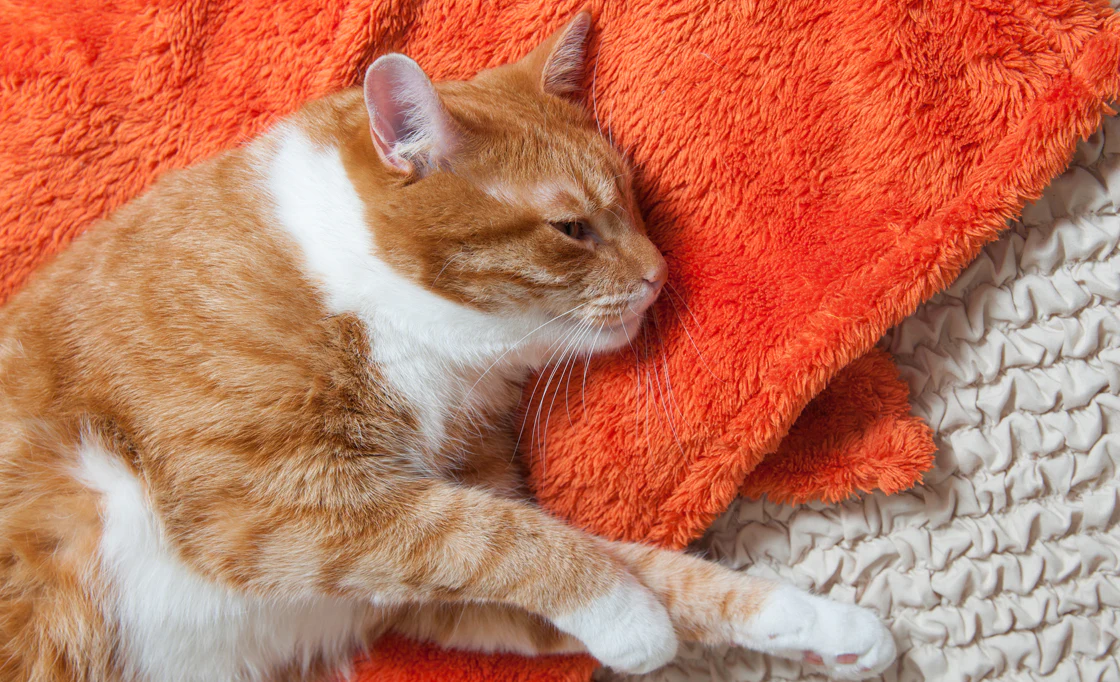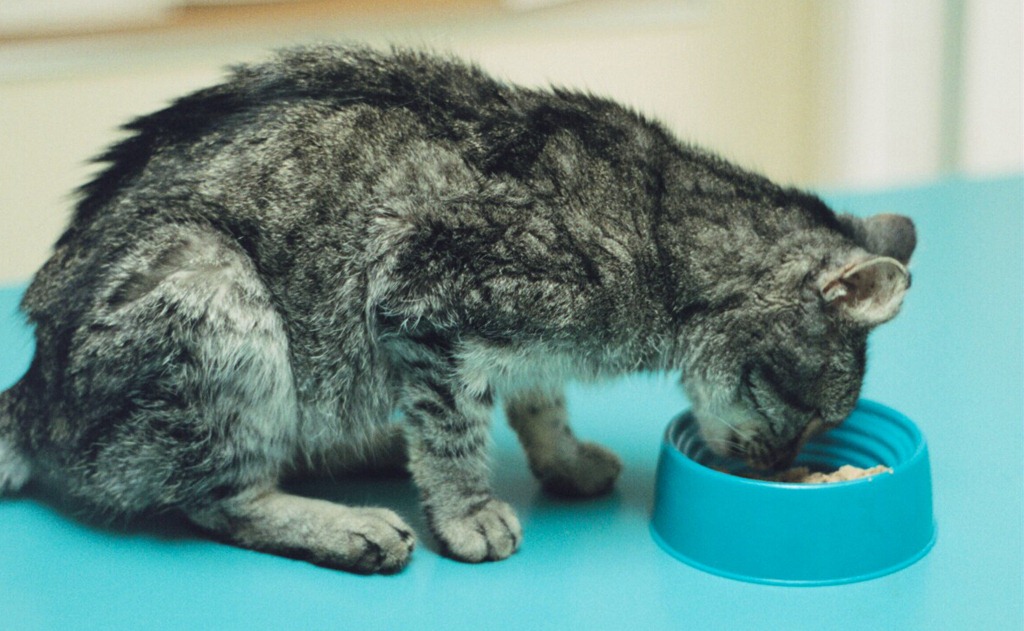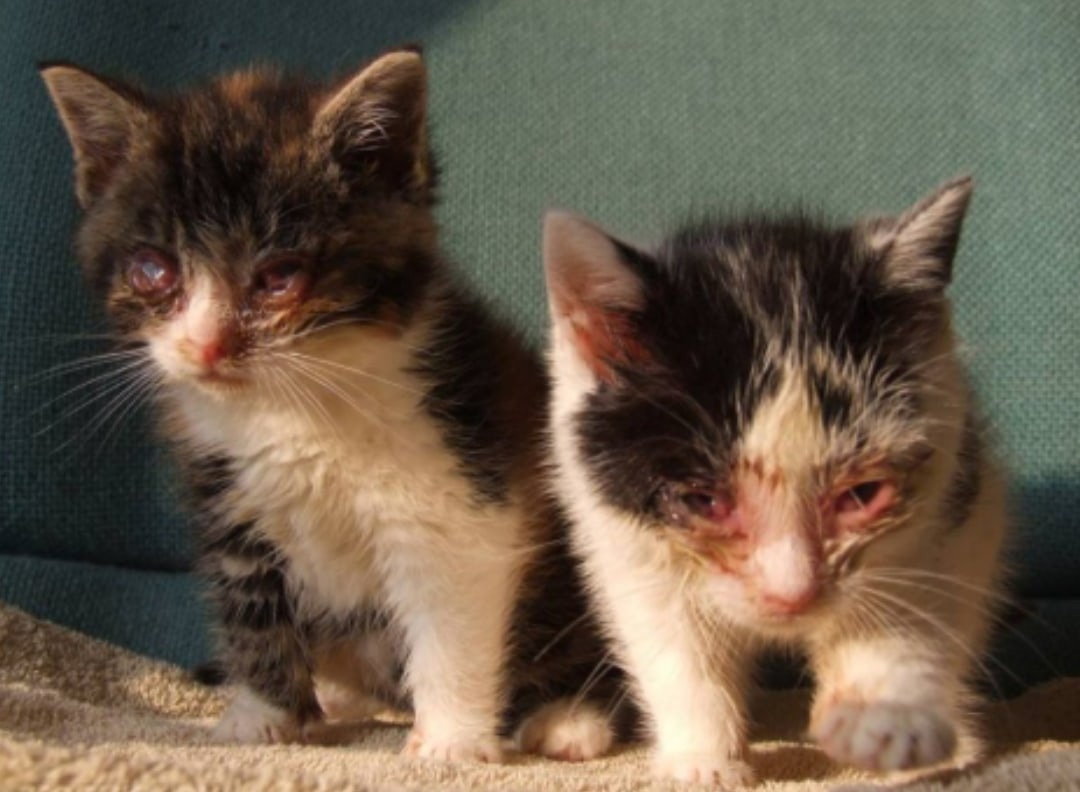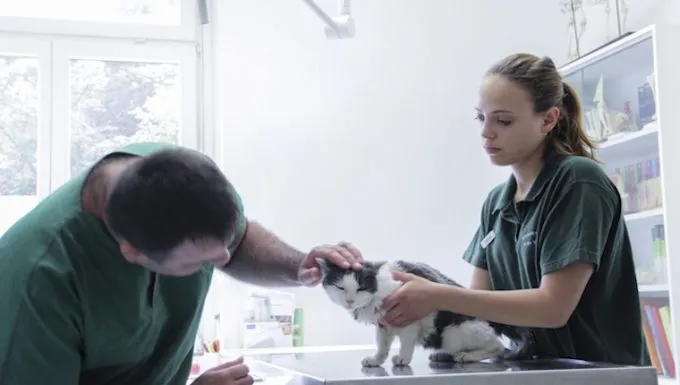Symptoms of Hypoglycemia in Cats
Physical Symptoms:

Hypoglycemia, also known as low blood sugar, can occur in cats and can be a life-threatening condition if left untreated.
Physical symptoms of hypoglycemia in cats may vary depending on the severity and duration of the episode, but common signs include:
Lethargy or depression: Cats with hypoglycemia may become lethargic, disinterested in their surroundings, and refuse to eat.
Shaking or tremors: Hypoglycemic cats may experience muscle tremors or shakiness, especially in the neck and head area.
Pupillary dilation: The pupils of a hypoglycemic cat’s eyes may dilate, indicating a lack of response to light.
Seizures or convulsions: Severe hypoglycemia can cause seizures or convulsions in cats, which can be life-threatening if not treated promptly.
Coma or loss of consciousness: In extreme cases, hypoglycemia can lead to a coma or loss of consciousness in cats.
It is essential to note that some cats may exhibit more subtle symptoms, such as:
Pancreatitis: Cats with pancreatitis may be at risk for developing hypoglycemia due to the inflammation and damage to the pancreas.
Diabetes mellitus: Cats with diabetes are more prone to developing hypoglycemic episodes, especially when their medication is not properly managed.
Cat owners should be aware of these potential symptoms and seek veterinary attention immediately if they suspect that their cat has developed hypoglycemia. Early detection and treatment are critical for preventing long-term consequences and ensuring the cat’s recovery.
Cats with hypoglycemia may exhibit physical symptoms such as shakiness, tremors, and muscle weakness.
Hypoglycemia, also known as low blood sugar, can occur in cats due to various reasons such as diabetes, liver disease, or certain medications. If left untreated, it can lead to serious complications and even death.
Physical symptoms of hypoglycemia in cats may include:
Shakiness: A cat with hypoglycemia may exhibit shakiness or tremors, which can be visible in their limbs or entire body.
Tremors: These are involuntary muscle contractions that can cause the cat’s muscles to twitch or shake uncontrollably. Tremors can range from mild to severe and may affect various parts of the body, including the head, neck, back, or legs.
Muscle weakness: A cat with hypoglycemia may experience muscle weakness or lethargy, making it difficult for them to stand, walk, or even move their muscles at all.
Abnormal breathing patterns: Cats with hypoglycemia may exhibit rapid or shallow breathing patterns due to the low blood sugar levels.
Others signs of hypoglycemia in cats include:
Confusion and disorientation
Stumbling or difficulty walking
Increased heart rate or palpitations
- Dilated pupils
In severe cases, hypoglycemia can lead to seizures, coma, and even death if not treated promptly. If you suspect that your cat is experiencing hypoglycemia symptoms, it’s essential to seek immediate veterinary attention.
Behavioral Changes:
Hypoglycemia in cats can be a serious medical condition that requires immediate attention if not treated promptly and effectively. One of the primary signs of hypoglycemia in cats is behavioral changes, which are often subtle but indicative of an underlying issue.
Initially, a cat experiencing hypoglycemia may become agitated or restless, pacing back and forth or meowing excessively. As the condition worsens, the cat’s behavior can shift towards lethargy, becoming quiet and withdrawn. The eyes may also appear sunken, indicating dehydration and lack of energy.
Other common behavioral changes in cats with hypoglycemia include loss of coordination, stumbling, or difficulty walking. They may also have a tendency to tremble or shiver due to the lack of glucose in their system. In severe cases, the cat’s vocalizations can become more urgent and distressing as they struggle to cope with the symptoms.
In some instances, hypoglycemic cats may exhibit unusual behaviors such as self-mutilation, chewing on furniture, or other destructive habits due to the discomfort and stress caused by their condition. These changes are often a result of the cat’s attempt to seek relief from the physical pain associated with hypoglycemia.
It is essential for cat owners to recognize these behavioral symptoms early on, as they can indicate an underlying issue that requires prompt veterinary attention. Prompt treatment can help prevent more severe complications and ensure the cat receives the care it needs to manage its condition effectively.
Owners should be aware of their cat’s baseline behavior and quickly identify any changes or deviations from normal, especially in cases where hypoglycemia is a concern. By staying vigilant and keeping an eye out for these behavioral symptoms, owners can help prevent more severe complications associated with feline hypoglycemia.
They may also show behavioral changes like confusion, disorientation, and altered gait patterns.
The symptoms of hypoglycemia in cats can be subtle and may not always be immediately apparent.
Common signs include:
Pale gums
Cool extremities
Tremors or shaking
Lethargy or depression
Weakness or collapse
Rapid breathing or panting
Increased heart rate
Vomiting or diarrhea
In addition to these physical symptoms, cats with hypoglycemia may also show behavioral changes like:
Confusion
Disorientation
Altered gait patterns
Restlessness or pacing
Whining or meowing excessively
In severe cases, hypoglycemia can lead to seizures, coma, and even death if left untreated. It’s essential for cat owners to recognize the signs of hypoglycemia and seek immediate veterinary attention if they suspect their cat is experiencing any of these symptoms.
Causes of Hypoglycemia in Cats

Pancreatic Insufficiency:
Hypoglycemia, also known as low blood sugar, is a serious condition that can occur in cats. It’s essential to understand the causes of hypoglycemia in cats to provide prompt and effective treatment.
One of the primary causes of hypoglycemia in cats is Pancreatic Insufficiency (PI). This condition occurs when the pancreas fails to produce sufficient enzymes, leading to a lack of glucose production in the body.
Pancreatic Insufficiency: A Leading Cause of Hypoglycemia
It’s essential for cat owners to recognize the signs of hypoglycemia, including trembling, lethargy, seizures, and collapse. If you suspect that your cat is experiencing hypoglycemia, seek immediate veterinary attention.
Hypoglycemia can occur due to pancreatic insufficiency, where the pancreas fails to produce enough insulin.
Cat owners often find it alarming when their pets exhibit symptoms of hypoglycemia, also known as low blood sugar. This condition can be caused by a variety of factors, including pancreatic insufficiency.
When the pancreas fails to produce enough insulin, glucose levels in the bloodstream begin to rise. Insulin is an essential hormone that enables cells to absorb and utilize glucose for energy production. Without sufficient insulin production, glucose builds up in the blood and eventually triggers a series of physiological responses designed to reduce its level.
One of the primary effects of hypoglycemia is the stimulation of glucagon secretion by the pancreas. Glucagon is another hormone produced by the pancreas that raises blood sugar levels by stimulating glycogen breakdown in the liver and muscles. When the body detects low blood glucose, it releases glucagon to prompt the liver to convert stored glycogen into glucose, which is then released back into the bloodstream.
However, if the pancreas is unable to produce enough insulin to facilitate glucose uptake in cells or if the liver fails to respond adequately by releasing stored glycogen, hypoglycemia can persist. This may be due to pancreatic insufficiency, where the pancreas has either been damaged or destroyed.
Another cause of hypoglycemia in cats is hepatic insufficiency, which involves a failure of the liver to store glycogen or to release glucose into the bloodstream effectively. If the liver is unable to perform these functions properly, it can lead to hypoglycemia.
Furthermore, certain conditions such as diabetes mellitus, pancreatitis, and gastrointestinal disease may also contribute to hypoglycemia in cats. In diabetic cats, the body may experience periods of insulin deficiency due to a lack of functional pancreatic beta cells or impaired glucose metabolism.
Cats with gastrointestinal disease may have reduced ability to absorb nutrients from food, including glucose. Similarly, pancreatitis can lead to damage of pancreatic tissue and decreased insulin production. These conditions often require prompt veterinary attention to prevent complications and ensure proper management of hypoglycemia.
Diabetes Mellitus:
Cats with diabetes mellitus are at risk for developing hypoglycemia, which occurs when blood glucose levels drop below a certain threshold. This can happen if a cat’s insulin levels become too high and glucose levels decrease as a result.
Another cause of hypoglycemia in cats is excessive fasting or skipping meals, especially in older cats who may have impaired liver function and be unable to store glycogen effectively.
Certain medications, including insulin, beta blockers, and certain antidepressants, can also contribute to hypoglycemia as a side effect, particularly if they lower blood sugar levels.
Ketosis-prone diabetes mellitus (KPD) is a type of feline diabetes that causes recurring episodes of hypoglycemia. This condition affects middle-aged to older cats and involves the pancreas releasing excess insulin in response to hyperglycemia, leading to rapid glucose depletion and potentially severe hypoglycemic episodes.
Cats with Cushing’s disease (hyperadrenocorticism) may also be at risk for hypoglycemia due to excessive cortisol production, which can interfere with the normal function of insulin and lead to blood sugar fluctuations.
Feline hepatic amyloidosis is a condition in which abnormal proteins accumulate in the liver, causing chronic disease and potentially disrupting glucose metabolism. Cats affected by this condition may develop hypoglycemia due to impaired glycogen synthesis and storage.
Finally, cats with feline leukemia virus (FeLV) infection may experience hyperglycemic crises leading to hypoglycemia as a result of insulin resistance or pancreatitis secondary to the viral infection.
Cats with diabetes mellitus are also at risk of developing hypoglycemia due to their inability to regulate blood sugar levels properly.
Cats with diabetes mellitus are also at risk of developing hypoglycemia due to their inability to regulate blood sugar levels properly. This condition can lead to a range of symptoms, including lethargy, confusion, and seizures.
Causes of Hypoglycemia in Cats:
There are several underlying causes that may contribute to the development of hypoglycemia in cats, including:
Insulin Overdose: Administering too much insulin can lead to a rapid drop in blood sugar levels, causing hypoglycemia. This is especially true for cat owners who do not have a proper understanding of their pet’s needs or are using low-quality insulin.
Fasting and Starvation: Cats that fast or starve for extended periods may experience hypoglycemia due to their inability to access food sources.
Severe Gastrointestinal Disease: Conditions such as inflammatory bowel disease, pancreatitis, or gastrointestinal foreign bodies can interfere with the normal absorption of nutrients, leading to hypoglycemia.
Pituitary Adenoma: This type of tumor can lead to hypoglycemia by suppressing the production of adrenocorticotropic hormone (ACTH), which plays a critical role in regulating blood sugar levels.
Adrenal Insufficiency: Cats with adrenal insufficiency may experience hypoglycemia due to their inability to produce sufficient cortisol, an essential hormone that regulates blood sugar levels.
Severe Chronic Illness: Certain chronic illnesses, such as kidney disease or liver failure, can impair the body’s ability to regulate blood sugar levels, leading to hypoglycemia.
Genetic Predisposition: Some breeds of cats are more prone to developing hypoglycemia due to their genetic makeup. For example, Siamese and Abyssinian cats may be at a higher risk of developing this condition.
Treatment and Prevention of Hypoglycemia in Cats
Emergency Care:
Hypoglycemia, also known as low blood sugar, is a condition that can affect cats of all ages and breeds, but it’s most common in kittens under six months old and senior cats.
Causes of Hypoglycemia in Cats:
Kitten hypoglycemia is often caused by a lack of nutrient-rich milk or formula, particularly if the mother’s milk production is insufficient or the kitten is not nursing properly.
Senior cats are more prone to hypoglycemia due to age-related changes in their pancreas and liver function, as well as decreased insulin sensitivity.
Hypothyroidism (underactive thyroid) can also contribute to hypoglycemia in cats.
Some medications, such as steroids and certain antibiotics, can lead to hypoglycemia as a side effect.
Symptoms of Hypoglycemia:
Weakness or lethargy
Confusion or altered mental state
Seizures or tremors
Loss of coordination or balance
Rapid heartbeat (tachycardia)
Poor appetite
Treatment and Prevention of Hypoglycemia in Cats:
Aim for an early diagnosis and prompt treatment to prevent seizures, brain damage, or even death.
Mild Cases:
Administer a small amount (0.5-1 mL) of corn syrup or honey per 10 pounds of body weight as an oral dose every few hours as needed.
Offer your cat’s usual food, and consider adding some easily digestible carbohydrates like cooked rice, bananas, or sweet potatoes to stabilize blood sugar levels.
Severe Cases:
Contact your veterinarian immediately if you suspect hypoglycemia in your cat.
Provide immediate intravenous fluids and glucose administration, which may be done by your veterinarian at the clinic or during an emergency visit to your home.
Prevention:
Kittens:
Nurse kittens frequently to encourage milk production and ensure they are receiving sufficient nutrients.
Feed a nutrient-rich kitten formula if the mother’s milk is insufficient or unavailable.
Senior Cats:
Monitor your senior cat’s blood glucose levels regularly, especially during periods of illness, stress, or changes in diet or medication.
Provide regular feeding times and a consistent diet to maintain stable blood sugar levels.
In case of an emergency, cats may require immediate treatment with glucose or other medications to stabilize their blood sugar levels.

Treatment and prevention of hypoglycemia in cats requires a comprehensive approach that involves identifying the underlying cause, stabilizing blood sugar levels, and implementing long-term management strategies to prevent recurrence.
When a cat is experiencing severe hypoglycemia, prompt treatment is essential to prevent serious complications such as seizures, coma, or even death. In an emergency situation, your veterinarian may administer glucose or other medications to quickly raise the cat’s blood sugar levels. This may involve giving the cat a glucagon injection, which can rapidly increase blood sugar levels.
Glucose supplements in the form of gel, syrup, or tablets can be given orally, but with caution, as excessive intake can lead to hyperglycemia (high blood sugar). In severe cases, intravenous fluids and glucose may be administered through a vein. It is crucial to monitor the cat’s vital signs closely during this process.
Once the cat has been stabilized, it is essential to identify the underlying cause of hypoglycemia. This may involve diagnostic tests such as blood work, urinalysis, imaging studies (e.g., X-rays or ultrasound), and hormone level assessments to evaluate the pancreas’ function. The veterinarian will also take a detailed medical history and perform a physical examination to rule out other potential causes.
Long-term management of hypoglycemia in cats may involve dietary changes, medication, or both. Feeding small, frequent meals high in fat and protein can help stabilize blood sugar levels. Your veterinarian may recommend a specific commercial diet or prescription food that meets the cat’s nutritional needs while minimizing the risk of hypoglycemia.
Certain medications, such as oral diazoxide or intramuscular glucagon injections, can be prescribed to manage persistent hypoglycemia. Diazoxide works by decreasing insulin release from the pancreas and increasing glucose levels in the blood. However, this medication has potential side effects and requires close monitoring.
Preventing hypoglycemia in cats involves identifying and addressing underlying factors that may contribute to low blood sugar. This includes providing a balanced diet, managing stress, and maintaining good health overall. Regular check-ups with your veterinarian can help monitor the cat’s condition and prevent complications associated with hypoglycemia.
Some additional preventative measures include:
Providing a nutritious diet that meets the cat’s nutritional needs;
Ensuring access to fresh water at all times;
Avoiding changes in environment, socialization, or routine that may cause stress;
Regular veterinary check-ups and blood tests to monitor the cat’s condition.
Lifestyle Changes:
Hypoglycemia, or low blood sugar, is a common condition in cats that requires prompt attention to prevent serious complications and even death. If your cat experiences hypoglycemia, it’s essential to understand the signs and symptoms, causes, and treatments to ensure their recovery.
Causes of Hypoglycemia in Cats:
Fasting or skipping meals for extended periods
Excessive exercise or playtime without adequate rest breaks
Underlying health conditions, such as hyperthyroidism, Cushing’s disease, or kidney disease
Eating spoiled or toxic food
Medications, such as insulin or certain antibiotics, which can cause hypoglycemia as a side effect
Lifestyle Changes:
Feed Small, Frequent Meals: Instead of feeding two large meals a day, split the daily ration into 3-4 smaller meals to maintain stable blood sugar levels.
Elevate Food Dishes: Place food and water dishes at different locations around the house to encourage your cat to search for food and stimulate their appetite.
Provide Treats Between Meals: Offer healthy treats, such as canned tuna or chicken broth, between meals to maintain energy levels and prevent hypoglycemia.
Exercise and Play: Provide regular exercise and playtime for your cat to stimulate their appetite and maintain physical activity.
Monitor Weight: Regularly check your cat’s weight and adjust food portions accordingly to prevent overfeeding or underfeeding, which can lead to hypoglycemia.
Additional Tips:
Careful Monitoring: Keep a close eye on your cat’s behavior and appetite, and seek immediate veterinary attention if you notice any signs of hypoglycemia.
Veterinary Care: Regular check-ups with your veterinarian are essential to monitor your cat’s health, adjust treatment plans as needed, and address any underlying conditions that may be contributing to hypoglycemia.
Preventing hypoglycemia requires regular feeding schedules and a balanced diet that includes highquality protein sources and complex carbohydrates.
Hypoglycemia in cats is a serious condition that requires prompt attention and management to prevent complications and improve outcomes.
Preventing hypoglycemia involves regular feeding schedules and a balanced diet that includes high-quality protein sources and complex carbohydrates. A well-planned feeding schedule can help regulate blood sugar levels, reduce the risk of hypoglycemia, and ensure overall feline health.
A list of high-quality protein sources for cats may include:
Lean meats: chicken, turkey, beef, fish (without bones or skin)
Fatty acids: salmon oil, flaxseed oil
Eggs: a rich source of protein and essential fatty acids
A balanced diet for cats should also include complex carbohydrates to provide sustained energy. Complex carbohydrates can be found in foods such as:
Grains: brown rice, oats, barley
Vegetables: green beans, sweet potatoes, carrots
In addition to a well-planned diet, owners can take several steps to prevent hypoglycemia in cats:
Provide regular meals: divide daily intake into 3-4 meals to maintain stable blood sugar levels
Maintain a consistent feeding schedule: ensure that meal times and amounts remain the same every day
Offer high-calorie treats between meals: can help stabilize blood sugar levels, especially for cats with diabetes or hypoglycemia
Monitor your cat’s overall health: be aware of signs and symptoms of hypoglycemia and seek veterinary care immediately if you suspect a problem
Provide emergency supplies: keep an emergency kit with glucose paste, treats, or other items that can help manage hypoglycemia on the go
Early recognition of hypoglycemia and prompt action are crucial in preventing complications and improving outcomes. If you suspect your cat is experiencing hypoglycemia, contact a veterinarian immediately for guidance and care.
- Best Clay Alternatives for 2025 - April 19, 2025
- Best Seamless.ai Alternatives for 2025 - April 19, 2025
- Best UpLead Alternatives for 2025 - April 18, 2025



